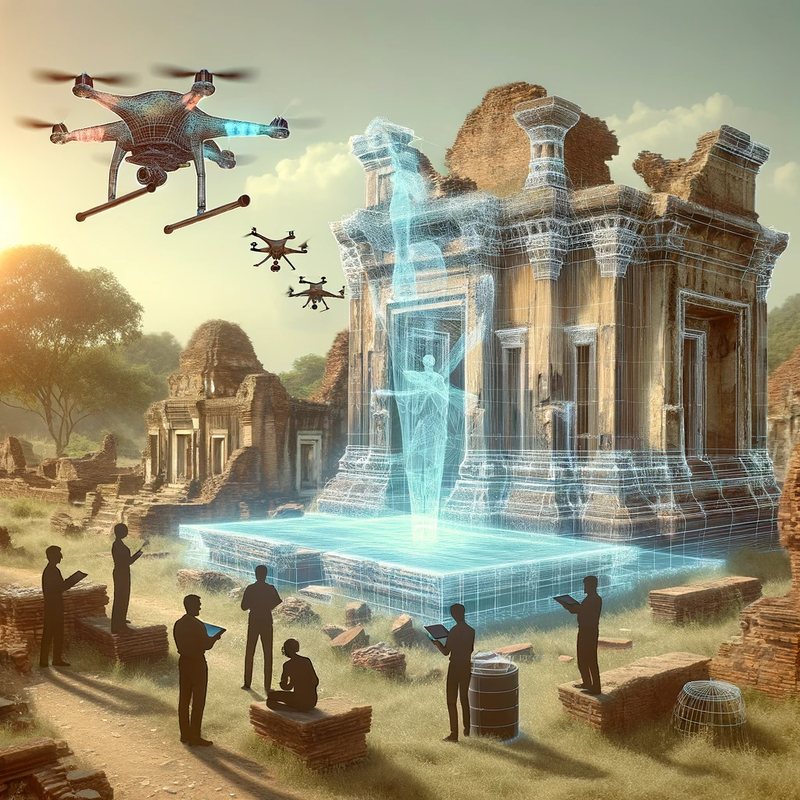Historical Preservation meets AI: Digital Reconstruction of Historical Monuments.
The profound link between history, culture, and architecture is tangible in the magnificent historical monuments and testimonials of bygone eras. These structures offer a glimpse into the past, revealing stories of cultures, civilizations, and epochs long gone. However, as time progresses, these architectural wonders face the relentless adversaries of natural calamities, human negligence, and the inevitable wear and tear of time. The mandate of preservation thus becomes paramount. Enter the realm of Artificial Intelligence (AI) - a tool that, when combined with the world of historical preservation, holds the promise of digitally resurrecting our cherished historical monuments. This synergy between historical preservation and AI, particularly in the realm of digital reconstruction, heralds a new age of architectural conservation.
The Fragility of Historical Monuments
Throughout the annals of history, countless monuments have either been destroyed or severely damaged. Natural disasters, wars, and sometimes, sadly, deliberate human destruction have led to the loss of significant sites. The ancient city of Palmyra in Syria, the Buddhas of Bamiyan in Afghanistan, and parts of the medieval city of Kathmandu in Nepal are poignant reminders of such losses.
However, with AI, the potential of restoring or digitally preserving these structures offers a beacon of hope. Digital preservation doesn't just mean creating a virtual replica of these structures; it means capturing their essence, significance, and the stories they hold.

Digital Reconstruction: The Process
The digital reconstruction of historical monuments, aided by AI, typically involves a multi-stage process:
- Data Collection : Before AI can work its magic, it requires data. Drones equipped with high-resolution cameras fly around the monument, taking thousands of photographs from various angles. Handheld cameras or laser scanners may be employed for interiors or intricate details. The idea is to gather as much visual information as possible.
- 3D Modelling : Once the images are collected, they're fed into specialized software that uses AI algorithms to stitch them together, creating a detailed 3D model. This model can be rotated, zoomed into, and explored, just like you'd do in a real-world tour.
- Texture and Details : One of AI's significant strengths is its ability to predict and fill in gaps based on the information it has. Suppose parts of a structure are eroded, or details are missing from photographs. In that case, AI can infer what these details likely were from the existing data, ensuring that the virtual representation is as close to the original as possible.
- Virtual Reality Integration : The final 3D model is often integrated into Virtual Reality (VR) platforms. This allows researchers, historians, and even the public to don VR headsets and "walk" through these historical sites, experiencing them in all their glory.
The Power of Machine Learning in Uncovering Lost Details
Machine Learning, a subset of AI, involves training algorithms on vast amounts of data to make predictions or decisions without being explicitly programmed. In historical preservation, we can train Machine Learning models on architectural styles, motifs, and designs from specific periods or cultures.
When faced with a ruined or partially destroyed monument, these algorithms can accurately predict what the original structure might have looked like. The digital reconstructions thus generated are not merely speculative renditions but are rooted in extensive historical and architectural data.
Educational and Cultural Implications
Digitally reconstructed monuments can serve as invaluable educational tools. AI can integrate them into academic curriculums, giving students a tangible sense of history, far removed from the abstract nature of textbooks. For communities with a compromised cultural heritage because of external invasions, conflicts, or other reasons, these digital reconstructions can play a therapeutic role, restoring a sense of identity and pride.

Ethical Considerations
While AI's intervention in historical preservation is overwhelmingly positive, it's not devoid of challenges. The primary concern is authenticity. While AI can predict missing details, there's always a margin of error. It's crucial to distinguish between what's historically accurate and what's an AI-generated fill-in. Clear disclaimers and transparency in the reconstruction process are vital.
Digital preservation should complement, not replace, physical preservation. The tactile, tangible experience of walking through a historical monument, feeling its walls, and breathing in its history is irreplaceable.
Looking Ahead
The confluence of AI and historical preservation represents a beautiful amalgamation of the past and the future. It showcases humanity's unwavering commitment to safeguarding its rich heritage while harnessing futuristic technology's power. As AI algorithms become more sophisticated, and our understanding of history deepens, the digital avatars of our cherished monuments will only become more accurate and evocative. They remind us that while we must always look ahead and innovate, it's equally crucial to look back, remember, and preserve.
Our Services
View some of our most popular services below.











